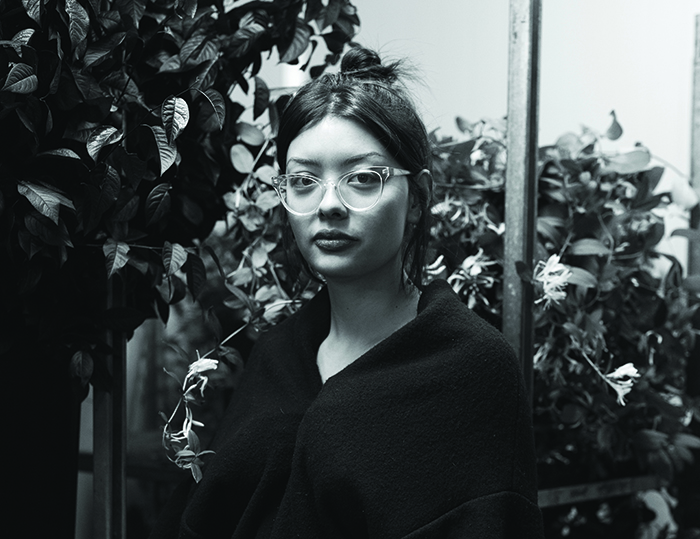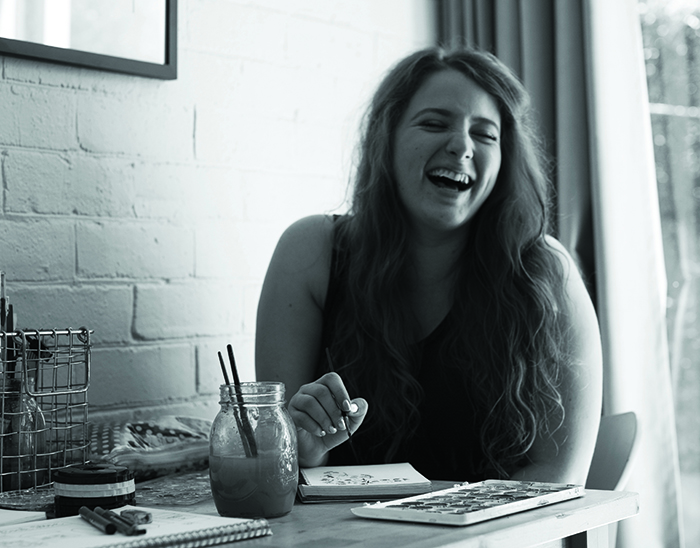They dance to the beat of their own drum, constantly redefining their professions for the better. Scoop talks to five local, proactive creatives forging individual paths in Perth.
ACTION MAN
Andrew Christie is a man who can't stand still. Even when he's being interviewed, the furniture-maker known as A Good Looking Man can't help but tinker. As we talk, he fixes a crooked wall panel that has fallen off his latest enterprise – an old boat he's turned into a public living space in Fremantle's King Square. Dubbed The Field Guide to Homemaking, the project was intended to act as a magnet for people to interact on a creative endeavour.
"I was looking to address a sinister male energy," he says. "I've been doing A Good Looking Man for almost four years now, and it's sort of shifted from commissions to doing these stranger, weirder things."
Andrew goes from project to project, sharing his knowledge of the arts and furniture-making with others, in the hope of enthusing unskilled and skilled workforces, and creating relationships and dialogue between people in the community, specifically males.
"A boat is a very masculine object that men will talk about. I had 20 to 25 people, predominately fathers, working on this, with various levels of skills and experience. Some were really unskilled, some were 70 and had built boats – and we were just conversing, learning, sharing and galvanising.
"Ever since I was a kid, I made cubby houses, and I built," he says. "I'm a maker. I was a special arts kid at Applecross, and then I studied fine arts at Curtin, painted for years, worked as a sculptor for years, and then was a filmmaker. I've danced around, and ultimately I'll come back to just sitting down with an easel."
At the moment though, he prefers a hammer and nails over a paintbrush. "I've got a make-believe job," he says. "More and more, it's just me working towards freedoms, where I don't want to own anybody else's time, I don't want them to own my time, and I just want to make a living as best I can."
.jpg)
Nic Brunsdon teams unused spaces with people who can best find uses for them.
BUILDING BLOCKS
"Frankly, I reckon traditional architecture is dead," says Perth-based Nic Brunsdon, who has taken a social approach to his profession.
After working as an architect in the Middle East, Nic quit in search of something more fulfilling. What he found was teaching at Curtin University, then what he likes to call 'anti-architecture architecture', through firms Spacemarket and Post-.
"We call ourselves social architecture," he explains,
"as in architecture for society, but also an apparatus for supporting life and communities."
Nic and his team pair disused spaces with useful people, through projects such as MANY 6160 and Moana project space. Now, once a month, the team brainstorms and develops crowdfunding ideas into real-life schemes. One such result is an app called Bother.
"You go around the city and notice spaces that are bothering you – so vacant lots, empty walls, whatever – and you upload them," Nic says. "If you're an artist or someone who's got some idea of what could be better about the community, whether it's an art installation or a pop-up bar or a tent, you can propose an idea for the space. Then the community votes on it and that winning one then goes into a crowd-funding period, finishes and it goes onto another."
Nic says this is the future for architects, or at least he hopes so.
"'Architect' is a word in technology now, meaning someone who can create and understand pathways, and that, potentially, is where we're going," he says. "I think the way that we win, as a society, is by everyone grabbing a piece of rope and pulling, and it doesn't matter in whatever direction, but you just need to engage in some way, because life is greater than just you. If you've chosen
to live or be of a place, you've actually got to become a proactive part of creating a better genesis or development of that place, otherwise you're just along for a free ride."

EARLY BLOOMER
"It's rustic and at times a little darker," says Sheridan Tjhung as she describes what makes Sheridan Tjhung Floral unique. "I'm not a girly girl, and my niche reflects that."
With contrasting, textural and daring floral installations, she's changing the way we view flowers, and it's not going unnoticed. At 22, and after just over a year officially in business, Sheridan has won over the likes of Perth artist Stormie Mills and UK fashion illustrator David Downton.
"I was taken aback when I met David," she says. "He saw my works and was like, 'I think you are wonderful, you are one of a kind.' To have that recognition from someone like him has been huge."
The self-taught florist has also worked alongside Perth fashion designer Natalie Rolt as well as succeeding at events such as Telstra Perth Fashion Festival, Myer SS15 Luncheon and Lakeside Joondalup's World's Longest Runway.
While the flower market in Perth is saturated, Sheridan has found a specific niche that reflects her creative side and adoration for flowers, including dabbling in pouring wax on her creations for a more dramatic approach.
"I use to always coat my fingertip in wax then peel it off, and admire the preserved fingerprint it left behind," she says. "In a sense, coating the flowers in wax is a mixture of my curiosity and preservation."
So what inspires Sheridan to create? "Necessity," she says. "Without it, I wouldn't know what I'm doing in life. It's a personal necessity and I have a desire to create. What do I have if I'm not creative?"

Carla's trawling of the internet provides her the material she needs for her art.
OUTSIDE THE BOX
Check out Carla Adams' internet bookmarks and you'd be forgiven for thinking she's a serial online dater. Craigslist and Chatroulette are frequented but, as this happily married artist says, it's all in the name of her projects.
"Because I make work about the internet, any time I'm looking at a dating site… that's research," Carla says. "I'm thinking about how to translate these websites, encounters or experiences into something visual, or into a tangible object. So the brain's always ticking over."
The artist's search history is very much the centre of her artistic practice, which features representations of men in the online realm, via paintings, textiles, tapestry, papier mache and clay sculptures.
"It's hard to be an artist and exist in this kind of post-internet world, but also it's really easy, because there's so much stuff to make art about," she says. "I'm in the studio all the time, I'm always making stuff. If I'm not teaching, I'm probably in the studio eight hours a day."
Carla – who teaches at Curtin University, curates for a number of galleries, and is program coordinator at Free Range Gallery – says it's really hard to just be an artist and make money from selling art.
"I think most artists probably have another job, and for me, it just made sense to get jobs that were still in the industry," she says. "I think when having an art practice, teaching and then doing arts work converge, that is when I'm most inspired to make work."
For those three things to work in synergy, Carla says you need to be able to multitask. "You need to be really good at admin, you need to be adept at curating, you need to be able to promote yourself," she says. "You need to be able to do these things because the art scene here is quite small. It just makes sense to me to put fingers in lots of different pies."
So what does her husband think of her fingers scrolling through all those online dating sites?
"I'm not going to run away with some internet guy, so I think it's fine."

The unsuccessful quest for decent stationery led Kelsie White to create her own.
BACK TO PAPER
If you thought the digital age had put an end to pen and paper, think again. Kelsie White's whimsical hand-painted notepads, cards and planners prove it's so much more fun to be organised when the paper is pretty. After all, what's the point of having a boring to-do list?
After searching high and low for stationery that gave her motivation
to study in a super-organised-yet- cute way, Kelsie came up blank. The solution? DIY.
"I started making them for myself," she says. "This led to some friends at university seeing what I was making, and they asked where I had bought them! That's what made me start printing them and making them for others." So, in 2014, Kelsie founded K Gets Organised, with a range of designs including watercolour flowers, sayings, pineapples and sweets.
Kelsie started networking and learning from Perth creatives who inspired her. "I spent time working for Petra Vanessie, learning all about markets, designing, and making your customers blissfully happy," she says. "I started learning styling from Emma of Dropstitch, and I was always attending The Creatives workshops by Stacey Clarke."
After finishing her political science and international relations degree, Kelsie moved onto graphic design, literally drawing inspiration from her contemporary life.
"I'm always inspired by the everyday," she says. "Things like a fresh bunch of flowers, a kind compliment from a stranger, the best coffee in the world." And where is the best coffee? "I head to Daphne on William Street pretty much every morning, which has the most beautiful couple behind the counter by far. They use white coffee cups, which I usually draw on later."
Kelsie has presented lectures around Perth, including Colour Society of Australia's #Girlboss, and is hoping to start up watercolour workshops in 2016.